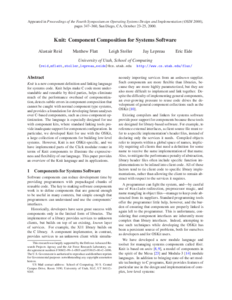Knit - Component Composition for Systems Software
Alastair Reid, Matthew Flatt, Leigh Stoller, Jay Lepreau, Eric Eide
University of Utah
[pdf]
[url]
4th Symposium on Operating System Design and Implementation (OSDI 2000)
San Diego, California, USA
October 2000
Abstract
Knit is a new component definition and linking language for
systems code. Knit helps make C code more understandable and reusable by
third parties, helps eliminate much of the performance overhead of
componentization, detects subtle errors in component composition that
cannot be caught with normal component type systems, and provides
a foundation for developing future analyses over C-based components,
such as cross-component optimization. The language is especially designed
for use with component kits, where standard linking tools provide
inadequate support for component configuration. In particular, we
developed Knit for use with the OSKit, a large collection of
components for building low-level systems. However, Knit is
not OSKit-specific, and we have implemented parts of the
Click modular router in terms of Knit components to
illustrate the expressiveness and flexibility of our
language. This paper provides an overview of the Knit
language and its applications.

BibTeX
@inproceedings{DBLP:conf/osdi/ReidFSLE00
, abstract = {
Knit is a new component definition and linking language for
systems code. Knit helps make C code more understandable and reusable by
third parties, helps eliminate much of the performance overhead of
componentization, detects subtle errors in component composition that
cannot be caught with normal component type systems, and provides
a foundation for developing future analyses over C-based components,
such as cross-component optimization. The language is especially designed
for use with component kits, where standard linking tools provide
inadequate support for component configuration. In particular, we
developed Knit for use with the OSKit, a large collection of
components for building low-level systems. However, Knit is
not OSKit-specific, and we have implemented parts of the
Click modular router in terms of Knit components to
illustrate the expressiveness and flexibility of our
language. This paper provides an overview of the Knit
language and its applications.
}
, affiliation = {University of Utah}
, ar_file = {OSDI_00}
, ar_shortname = {OSDI 00}
, author = {Alastair Reid and
Matthew Flatt and
Leigh Stoller and
Jay Lepreau and
Eric Eide}
, booktitle = {4th Symposium on Operating System Design and Implementation (OSDI 2000)}
, day = {23-25}
, editor = {Michael B. Jones and
M. Frans Kaashoek}
, file = {knit-osdi00.pdf}
, link = {http://dl.acm.org/citation.cfm?id=1251253}
, location = {San Diego, California, USA}
, month = {October}
, pages = {347--360}
, png = {knit-osdi00.png}
, publisher = {USENIX Association}
, title = {{K}nit: {C}omponent {C}omposition for {S}ystems {S}oftware}
, url = {http://dl.acm.org/citation.cfm?id=1251253}
, year = {2000}
}
